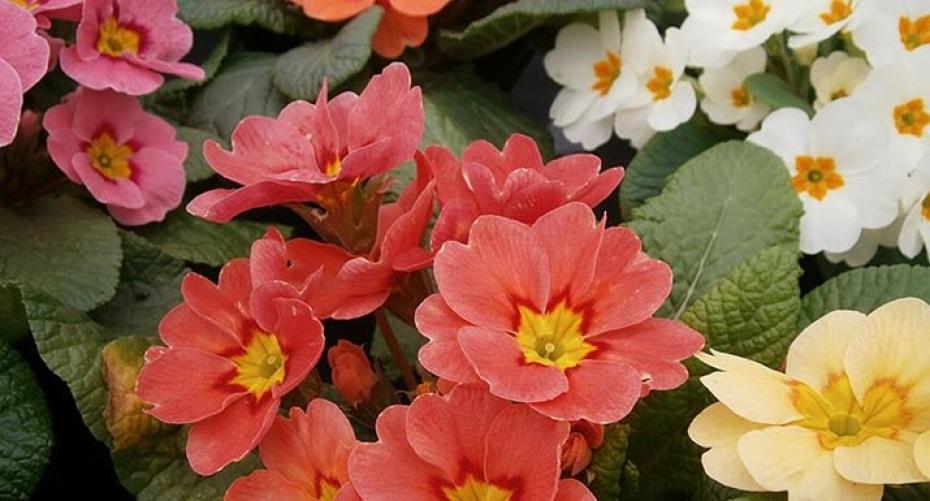Plant Primulas to perk up those dull winter days
Primula are a large genus of brightly coloured plants of approximately 500 species, by far the most are sold from late autumn through to spring as bedding plants. They are perfectly hardy, can be grown from seed or bought as plugs or established plants for instant colour. They look good in a cottage garden, as formal bedding, in containers or in the woodland garden. They are thought to be a hybrid of the common primrose (Primula vulgaris) and the cowslip (Primula veris). They began to be called Polyanthus in the 1670’s. They flower from February to May, exactly when they start to flower will depend upon the weather conditions, a harsh winter will delay flowering until conditions improve. They have been used as a medicine, in Eastern Europe, to relieve bronchitis, pneumonia, flu, dizziness, headaches, sleeplessness and rheumatic pains. These claims however have not been scientifically proven.
Position
They like a fertile, moist but well drained soil in sun or dappled shade. If growing in containers use a good quality peat-free multi-purpose compost with some slow release fertiliser added.
Sowing
Sow the seed in summer for flowering the following spring. Sow in trays of seed compost and place in a warm sheltered position out of the rain. Keep the compost just damp and prick out into single pots, using John Innes No2 compost, as soon as the seedlings are large enough to handle. If they have been grown in a greenhouse gradually harden them off by increasing the amount of time they spend outside, until by early autumn they are fully outside. Once they have made substantial plants plant into their flowering positions.

Plugs
Pot up into a 9cm (3.5”) pot as soon as you receive them, using John Innes No2 compost. Let them establish a good root system by keeping them somewhere warm and light. Gradually harden them off before planting outside.
Planting
If the soil is heavy clay or light sand improve it with good quality peat-free multi-purpose compost and a little slow release fertiliser. Water well after planting and ensure they stay moist, but don’t overdo the watering in winter as they are liable to rot.
Aftercare
Keep moist but not sodden. Remove any yellow leaves and deadhead regularly to ensure a continuous supply of flowers. If planted in containers without a slow release fertiliser, feed every fortnight with a high potash feed, such as Tomorite.
If growing in containers once they have finished flowering either discard or plant in a corner of the garden until they are ready to flower again next autumn. If planted in the open garden just leave them to naturalise. They will eventually form a large clump and flowering will diminish so dig them up after flowering, split into small plants then re-plant.
Pests and diseases
They are relatively disease and pest free, although they will succumb to slug damage if it is a mild winter.
Keep an eye out for moulds; removing the infected parts as soon as it is spotted is the best control, along with making sure they are not too wet.
Recommended varieties

‘Gold Lace’, a black/burgundy and gold laced plant is an historic variety from the 1780’s which also has the benefit of being loved by the bees and butterflies.
‘Crescendo Mixed’ is a strain of F1 hybrids which are only available as plants. They have a large quantity of bright blooms and reach a height and spread of 23cm (9”). The blooms are long-lasting, strong and fragrant. The flowers are edible so are ideal for adding a splash of colour to a winter salad.




![Kingsbury-bench-05[1].jpg](http://www.hayesgardenworld.co.uk/cdn/shop/files/Kingsbury-bench-05_5B1_5D.jpg?v=1712162737&width=1500)
![Kingsbury-bench-01[1].jpg](http://www.hayesgardenworld.co.uk/cdn/shop/files/Kingsbury-bench-01_5B1_5D.jpg?v=1712161065&width=1500)
![tw17a-4947_0[1].jpg](http://www.hayesgardenworld.co.uk/cdn/shop/files/tw17a-4947_0_5B1_5D.jpg?v=1712161495&width=1500)
![tw17a-4947_tenbury_5ft[1].jpg](http://www.hayesgardenworld.co.uk/cdn/shop/files/tw17a-4947_tenbury_5ft_5B1_5D.jpg?v=1712161172&width=1500)
![tw17a-4952_tenbury_4ft[1].jpg](http://www.hayesgardenworld.co.uk/cdn/shop/files/tw17a-4952_tenbury_4ft_5B1_5D.jpg?v=1712161034&width=1500)
![siena_twinseat[1].jpg](http://www.hayesgardenworld.co.uk/cdn/shop/files/siena_twinseat_5B1_5D.jpg?v=1712226555&width=1500)
![thumbnail_IMG_1565-kik_2[1].jpg](http://www.hayesgardenworld.co.uk/cdn/shop/files/thumbnail_IMG_1565-kik_2_5B1_5D.jpg?v=1712226536&width=1500)
![thumbnail_IMG_1565-kik_1[3].jpg](http://www.hayesgardenworld.co.uk/cdn/shop/files/thumbnail_IMG_1565-kik_1_5B3_5D.jpg?v=1712159637&width=1500)


